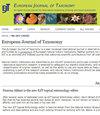Bryozoan statoblasts from lake sediments in Madagascar, including two new species
IF 1.3
3区 生物学
Q3 ENTOMOLOGY
引用次数: 0
Abstract
Madagascar is a freshwater biodiversity hotspot, yet the current understanding of freshwater bryozoan diversity is limited. Using a dissecting microscope, bryozoan statoblasts were collected during macrofossil analysis of a sediment core, which was taken from Lake Sofia, Madagascar, in 2019. There was a peak in the abundance of statoblasts prior to 1900, with 67 statoblast valves found at 45.5 cm and a decline in more recent sediments. A subsample of 14 specimens was examined under a scanning electron microscope to determine species identification. One of the species found was Plumatella kinesis. Two new species, Plumatella tsimiheta sp. nov. and Plumatella sofiae sp. nov. were also found and described. These results show the potential of lake sedimentary bryozoan remains for categorising species presence and distribution. Although poor preservation was a limitation for identification, there is still value in having a historical record of past biodiversity, especially when species may no longer be extant. This study highlights the need for further research to better understand the status of these species and other potential new species of bryozoan in Madagascar.马达加斯加湖沉积物中的苔藓虫类statoblasts,包括两个新种
马达加斯加是淡水生物多样性的热点地区,但目前对淡水苔藓虫多样性的了解有限。使用解剖显微镜,在对2019年从马达加斯加索非亚湖采集的沉积物岩心进行大化石分析时收集了苔藓动物的statoblasts。在1900年之前,statoblast的丰度达到顶峰,在45.5厘米处发现了67个statoblast阀,在最近的沉积物中有所下降。在扫描电子显微镜下检查了14个标本的亚样品,以确定物种鉴定。其中发现的一种是Plumatella kinesis。此外,还发现并描述了2个新种:齐氏Plumatella tsimiheta sp. 11和sofiae sp. 11。这些结果显示了湖泊沉积苔藓虫遗骸在分类物种存在和分布方面的潜力。虽然保存不佳是鉴定的一个限制,但拥有过去生物多样性的历史记录仍然有价值,特别是当物种可能不再存在时。这项研究强调了进一步研究的必要性,以便更好地了解这些物种和马达加斯加其他潜在的苔藓虫新种的状况。
本文章由计算机程序翻译,如有差异,请以英文原文为准。
求助全文
约1分钟内获得全文
求助全文
来源期刊

European journal of taxonomy
ZOOLOGY-
CiteScore
2.30
自引率
8.30%
发文量
173
审稿时长
29 weeks
期刊介绍:
EJT is a fully refereed, international, fully electronic Open Access journal in descriptive taxonomy, covering subjects in zoology, entomology, botany (in its broadest sense), and palaeontology. EJT-papers must be original and adhere to high scientific (content) and technical (language, artwork, etc.) standards. Manuscripts that are clearly substandard in either of these categories will not be sent out for review. EJT is supported by a consortium of European Natural History Institutes, but its scope is global. Both authorship and geographical region of study need not be European. Authors are, however, strongly encouraged to involve European Natural History collections by consulting material or by depositing specimens (e.g. types and figured material) related to their published paper in the collection of a European Natural History Institute.
 求助内容:
求助内容: 应助结果提醒方式:
应助结果提醒方式:


